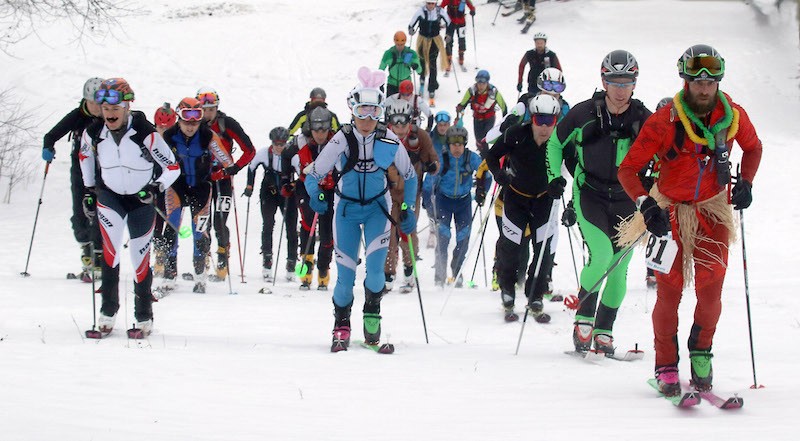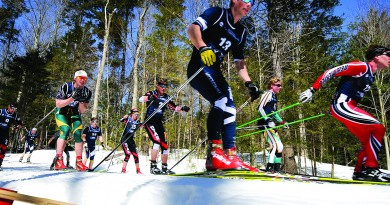Are you tough enough?
Vermonters take a masochistic pleasure in winter. In the past few years, that masochism has been fueled by a growth of extreme races. (Note: originally published 2/9/ 2016 this story was updated on 2/22/2017.)
Photo by Herb Swanson
“The initial ascent from the lower base to the summit was a mix of good skinning, very tricky skinning, and four bootpacks (i.e., eight transitions for a single ascent). The very long bootpack on the middle stretch kept you paying attention with sudden changes between postholing, rock and ice. East Bowl was a mix of frozen moguls, ice, grass and rocks with an inch or so of fresh snow obscuring all of the aforementioned hazards. So overall, excellent race conditions!”
Such was a Facebook post about the 2016 Q Burke Backcountry Adventure Ski Mountaineering course, which drew competitors from as far as Oregon and Colorado and sent them on a “tour” of a 7.5 mile course, with more than 4,000 feet of vertical gain and 17 transitions.
Dressed in a red speed suit, grass skirt and draped in Hawaiian leis, Marshall Thompson had a ball. The Crested Butte, Colo., native zipped around the course in 1 hour, 50 minutes, beating second-place finisher by George Visser, of Bromont, QC by four minutes. Visser shouldn’t feel so bad: Thompson won the 2014 Ski Mountaineering U.S. National Championships.
Increasingly, Vermont is becoming a destination for mountaineers and endurance athletes from around the country with a spate of new races that are challenging even the toughest Rocky Mountain natives.
In 2016, the Endurance Society’s “Extremus” sent hikers on a 50-mile non-stop group trek along the Long Trail and participants in the Society’s “Frigus” snowshoed, skied and sledded (or any combination of thereof) around the Moosalamoo backcountry at Blueberry Hill.
Each February, the Camel’s Hump Challenge sends skiers on a 13-mile, five- to seven-hour loop around Camel’s Hump to raise money and awareness for the Alzheimer Foundation.
In 2017, the Catamount Trail Association has hosted a series of uphill events at resorts around Vermont and in 2016 put on the second-ever 24-hour backcountry ski mountaineering race to benefit Vermont Adaptive Ski and Sports.
For those who still have legs, on March 19 (2017) Sugarbush also hosts the longstanding Mad River Valley ski mountaineering race that has contestants climbing, descending and traversing. In 2016 the course ran 7.8 miles along three peaks as well through the backcountry of the Slide Brook Basin Wilderness. This year, the course is being deemed more “spectator friendly.”
If that sounds like child’s play, Joe De Sena (founder of the Spartan and Death races) has a few entertaining events planned in Pittsfield. On March 11, 2017 there’s a Peak Snowshoe Race with a 100-mile option. This summer, June 2-4 De Sena will host a summer “Agoge”, a 60-hour test of mental and physical stamina. Though the details remain secret, the event noted that “to complete the Spartan Agoge, one overcomes mental and physical obstacles that aim to develop the body, mind and spirit. Most people will need to undertake months of learning, training and self-discovery to earn what will become a coveted achievement.”
And you can cap off winter with Rasputitsa, the East Burke gravel grinder bike race that sometimes involves hiking your bike through snowdrifts. The ride, which has drawn top cyclocross racers from around the U.S., has benefitted Lea Davison’s Little Bellas.
How far is too far?
“The chance to push your limits and see how your body and mind react is something most people don’t get to do,” says Christina Kumka. She should know: A strong athlete who recently ran 104 miles in 48 hours during the 2016 Infinitus race in Goshen, Kumka was one of two people who called for rescue during the 2016 Extremus, the 50-mile “group hike” along the Long Trail.
Though the weather seemed deceptively mild for that event, gusts at the top of Mt. Mansfield measured 117 mph and rain beat down hard. After hiking more than 25 miles two participants, including Kumka, became disoriented, hypothermic and even started hallucinating. “I kept seeing suitcases and black cats in the woods,’ Kumka recalled. They called ahead to the rest of the group holed up at Taylor Lodge and triggered a call to Stowe Mountain Rescue.
“Confronted with the situation they were in, the folks did the right thing in asking for help. The race organizers called 911 and put an emergency rescue into action,” says Neil Van Dyke, Search and Rescue Coordinator at the Vermont Department of Public Safety.
“In my experience of 40 years in search and rescue the most life threatening conditions are when it is wet and cold—35 degrees wet and windy is more dangerous than 15 below zero. When you get wet, we consistently see hypothermia in temperatures,” Van Dyke notes.
In 2014 ago young man hiking in Fayston in 40 degrees died of hypothermia, Van Dyke recalls. “At the point the call came in for help during Extremus it was raining hard with temperatures in the 40s.” The rescue party and the rest of the Extremus group were able to locate the two and help them walk out. Both were treated for hypothermia.
Van Dyke’s position was created by the legislature in 2013 after state police found a boy’s car found at 5 pm a trailhead in Ripton that January. They failed to conduct a search and rescue that night. The boy, Levi Duclos, 16, died on the trail of hypothermia.
Part of Van Dyke’s role is to work now with search and rescue teams around the state and also to work with event organizers to ensure even the toughest races have adequate safety measures.
The State of Vermont requires a permit and a safety plan for every event held on state land. Van Dyke works with the organizers, as he did with Andy Weinberg and Jack Cary, organizers of Extremus, to make sure that the “what ifs…” are all answered.
“While we have strict permitting requirements on state land,” Van Dyke notes, “I am not sure Federal land permits get the same scrutiny.
Van Dyke, himself an avid outdoorsman, understands both the allure and the risks involved in extreme event. “When people play in the outdoors, things are bound to happen. I’m pretty careful not to pass judgement and it’s a fine line from when something goes from being reasonable to being reckless.”
And that line varies with every individual.
*Note: This story was updated on February 22, 2017.





Pingback: Vermont Sports Magazine, Feb. Mar. 2016 - Vermont Sports Magazine